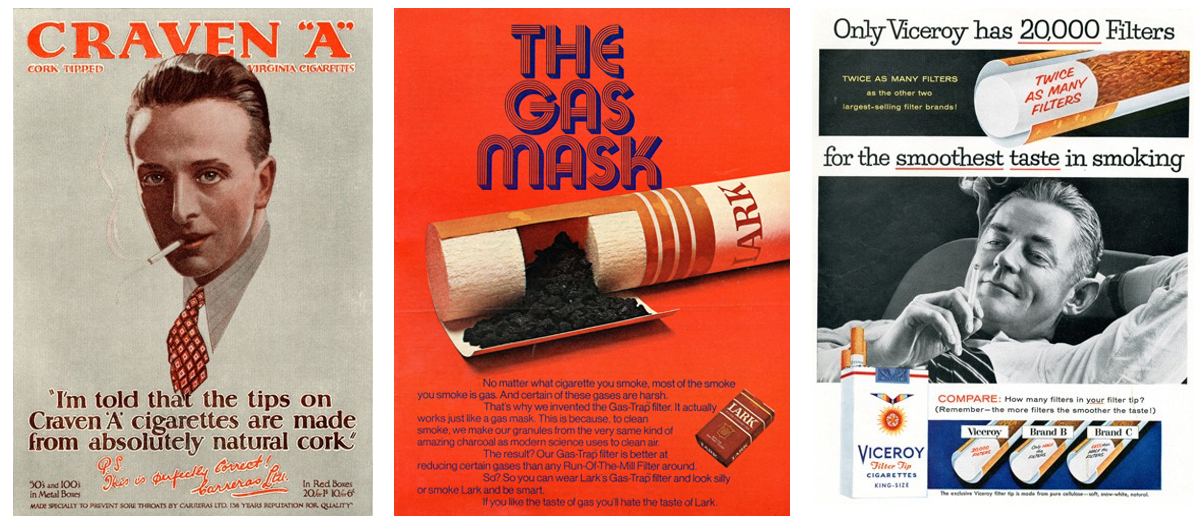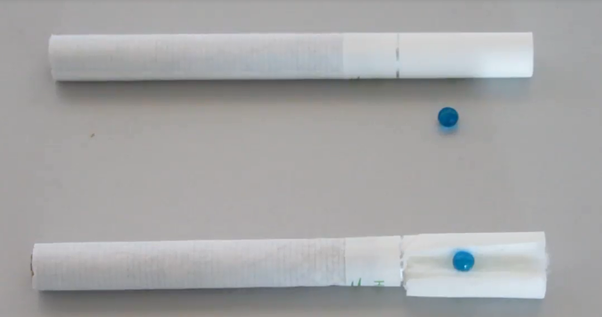The Government’s proposed Smokefree Aotearoa 2025 Action Plan sets out a perceptive vision for reducing smoking prevalence and ensuring that, once the goal is reached, future generations will remain smokefree. Among the evidence-based measures set out, the plan includes proposals to “make smoked tobacco products less addictive and less appealing”. In this blog, we examine the Government’s specific proposal to prohibit filters and disallow innovations, additives, and other product changes that sustain the appeal and addictiveness of smoked tobacco products.
How did filters become an integral component of cigarettes?
Cigarettes initially had no filters. Historians suggest filters were first introduced to create a barrier between the tobacco in a cigarette stick and a smoker’s mouth (though cigarette holders may have performed a similar function before then). Even before evidence about smoking’s harms was clearly documented, cigarette advertising suggested filters provided throat protection, as seen in the Craven A advertisement, which claims the brand was: “Made specially to prevent sore throats” (see Figure below).
As the harms of smoking became well-established,1 2 filters’ role as a potential “reduced risk” tool expanded, and claims to this effect featured strongly in cigarette advertising from the 1950s onwards. The 1960 Lark advertisement below highlights the charcoal filter the brand used, which drew on “modern science” promoting charcoal use “to clean smoke”. By contrast, the Viceroy advertisement uses comparative claims to imply superior filtration and taste, thus encouraging perceptions that filters may improve the experience smokers sought from their brand.
Source: Stanford University Research Into the Impact of Tobacco Advertising website.
The harm-reduction myth
These advertisements illustrate tobacco companies’ search for a solution to growing health “controversies” regarding smoking. Advances in manufacturing and plastics technology led to cellulose acetate’s identification as a suitable filter material and enabled wide-scale implementation of this fundamental change in cigarette design.3 By the 1990s, filters had been so effectively marketed as harm-reduction tools that non-filtered cigarettes held only a negligible market-share.4
Analyses of industry documents suggest that, while this product innovation may have begun as an effort to manage risk, it evolved into large-scale consumer fraud as tobacco companies’ own research found filters had no material effect on eliminating toxins from smoke.3 Because filters made drawing on a cigarette more effortful, tobacco companies introduced filter ventilation; vents, or small perforations around the filter to make “dragging” easier. Filter ventilation also changed in the machine-smoked yield of tar and nicotine, which led companies to imply that ‘light’ and ‘low tar’ cigarettes were less harmful than “regular” variants.5 Even after regulators banned the use of these terms, tobacco companies have used other variant names such as “smooth” and “fine”, which appeal to consumers and continue this deception.6
Claude Teague, a scientist working on filters for the tobacco company RJ Reynolds, found that changing the pH of filters led these to discolour after smoking, thus creating the misleading impression that filters removed toxins and thus rendered smoking safe. He wrote: “The cigarette smoking public attaches great significance to visual examination of the filter material in filter tip cigarettes after smoking the cigarettes. A before and after smoking visual comparison is usually made and if the filter tip material, after smoking, is darkened, the tip is automatically judged to be effective. While the use of such colour change material would probably have little or no effect on the actual efficiency of the filter tip material, the advertising and sales advantages are obvious.”5
A report on Vantage cigarettes conducted for RJ Reynolds revealed how successfully filters reassured smokers: “Vantage smokers believe that the filter itself is strong enough to catch these impurities and that the whole structure is such that they will not see so much of the resulting discoloration. These ideas make them think the end product is a milder and more ‘healthful’ smoke.”7 Filters became a harm-reduction symbol to counter the growing threat from the overwhelming evidence of smoking’s harms, thus reassuring smokers and dissuading them from quitting.
Filter innovations to recruit youth
Despite changes to cigarette design and the sophisticated marketing of filter innovations, smoking prevalence continued to decline, leading tobacco companies to create new products designed to recruit replacement smokers and so maintain their revenue streams. Thus, in the 2000s, filters began to assume the new role of attracting smokers by carrying flavour beads, or capsules, which smokers could crush to flavour the smoke and customise their smoking experiences. While most capsule variants offer menthol or mint flavours, fruit flavours are increasingly common, as have cigarettes with two differently flavoured capsules in the same filter.
Filters containing flavour capsules may appear a surprising innovation, given established adult smokers typically cite taste as a main reason for selecting “their” brand, to which most smokers are “brand loyal”.8 Nevertheless, flavour capsule cigarette sales have grown rapidly, even in markets where overall tobacco consumption is declining, such as New Zealand.9-11 Research indicates that, despite tobacco companies’ asserting their marketing aims to increase brand share rather than attract new users,12 flavour-capsule cigarettes appeal more to susceptible young adult non-smokers than to young adult smokers.13 The rapid growth in capsule sales is thus more likely to reflect recruitment of new, predominantly young “replacement smokers” than it is to stimulate brand switching among existing smokers.
Environmental harm
As well as misleading smokers and attracting non-smokers, filters cause major environmental harm. Each year, around four trillion cigarette butts are discarded globally, making tobacco product waste (TPW) the most commonly littered item in the world.14 A recent NZ National Litter Audit also reported that cigarette butts were the most frequently identified litter item.
Because cigarette butts predominantly comprise a poorly biodegradable cellulose acetate filter (a form of plastic), this waste contains chemical toxins from tobacco and contributes to microplastic contamination in the environment. Tobacco waste deposited on beaches and in urban environments eventually enters rivers, lakes and streams, and moves out to sea, where it contributes to accumulating plastic mountains.15-18
This environmental contamination should be of concern to all countries and has particular salience to New Zealand, which has drawn heavily on its natural environment to market itself as a global tourism destination. As well as harming people and wildlife, tobacco product waste threatens New Zealand’s “100% pure” tourism identity.19 Given growing international concern about plastic waste, it is surprising that the Royal Society of New Zealand’s recent report on plastics mentions cigarette filters only twice in passing and makes no specific recommendations to reduce TPW. Pollution of waterways with toxic waste is also problematic under Te Tiriti, given the cultural importance of waterways to Māori and the role these play as food sources.
Despite knowing that filters convey misleading harm-reduction connotations and contribute to environmental contamination, and in spite of evidence that many people believe cigarette butts are biodegradable,20 21 tobacco companies have relocated responsibility for TPW prevention to people who smoke, to voluntary clean-up efforts, and to local authorities.22 This downstream orientation underlies industry calls to increase the availability and distribution of butt receptacles and shifts attention away from tobacco companies’ role in creating a product they know is harmful to human health as well as the environment.22 Ironically, as recently as 2020, British American Tobacco cited its support of the anti-litter “Keep New Zealand Beautiful” programme as evidence of its commitment to sustainability.
Tobacco companies’ efforts to frame themselves as socially responsible corporate entities willing to invest in environmental initiatives have undermined effective tobacco control policies.23 Surveys show that the public (smokers and non-smokers alike) view people who smoke as responsible for TPW, with fewer allocating responsibility to tobacco companies.21 This focus on individuals, or down-stream actors and voluntary groups, suits the tobacco industry’s interests and ignores evidence that up-stream interventions, such as changes in tobacco product design, will be far more effective in reducing the environmental burden of TPW.24 25
Why banning filters is the optimal policy measure
For the three reasons outlined above, the NZ Government’s proposal to remove filters will finally acknowledge the harms these cigarette components cause. Some jurisdictions have already responded to the environmental threats filters pose; for example, members of the New York state legislature have proposed a statute banning the sale of single use filters (and e-cigarettes). The (European Union EU) Directive 2019/904, which aims to reduce the impact certain plastic products have on the environment, also addresses TPW, though the directive proposes developing biodegradable alternatives rather than banning all filters.
While designing filters from alternative, less environmentally harmful, components may seem an appropriate compromise, this measure would likely further mislead smokers. For example, it would encourage them to view discarded butts as harmless, even though toxic chemicals would still be leached into the environment. Further, biodegradable filters would leave unaddressed both the decades-long consumer fraud that tobacco companies’ promotion of filters has perpetuated and the use of innovations, such as capsules, that recruit “replacement smokers” to continue. Only removing filters completely will eliminate a significant portion of TPW, address consumer deception, protect young people, and encourage smoking cessation.
Implementation
Tobacco companies may fight to preserve the elaborate and long-standing fraud perpetuated by cigarette filters; however, they have no legitimate argument to oppose this measure. More than half a century ago, tobacco companies issued a “Frank Statement” in response to growing concerns about the harms smoking causes. In that statement, they claimed they “always have and always will cooperate closely with those whose task it is to safeguard the public health”. This promise calls into question tobacco companies’ sustained opposition to every public health policy that would curtail smoking prevalence. The NZ Government’s proposal to ban filters gives tobacco companies an opportunity to remove filters voluntarily, ahead of legislation. Doing so would act on their longstanding knowledge of the misperceptions associated with filters and show some belated consistency with their expressed concern for “public health”.3 4
Anecdotal claims suggest that people who smoke may develop alternatives to filters, such as cardboard. However, smokers who have tried this strategy report it as ineffective. Furthermore, the effort required to prepare these alternatives several times a day suggests that, like other avoidance measures, such as using sleeves to avoid exposure to standardised packs, the behaviour would decline quickly over time.27 Tobacco companies may offer filter alternatives, for example, by reintroducing cigarette holders, but policies could pre-empt this strategy by banning sales of merchandise that could facilitate smoking, including cigarette holders.
Given the absence of reasonable, science-based objections, introducing and implementing a ban on cigarette filters should be straightforward. Recent commentaries suggest treating filters as additives25 could allow bans to be introduced using existing regulations and would simplify the introduction of this measure.
In summary, banning the sale of filters and filtered cigarettes would address a persistent consumer fraud that has deceived generations of smokers, and reduce the tobacco industry’s ability to develop product innovations that sustain its profits at the expense of human health. This measure would also remove a ubiquitous source of toxic plastic waste from our environment. Disallowing filters would support the 2025 Smokefree Goal, reinstate New Zealand as a global public health leader, and illustrate a much-needed commitment to protecting our environment.
* Author Details: Hoek is a Professor of Public Health (and was formerly a Professor of Marketing); Gendall is an Emeritus Professor of Marketing at Massey University; Novotny is an Emeritus Professor of Global Health at the San Diego State University; Robertson is a Senior Research Fellow in the Department of Preventive and Social Medicine; Wilson and Edwards are Professors of Public Health; Thrasher is a Professor of Health Promotion, Education, and Behavior.
All authors except Professors Novotny and Thrasher are members of the ASPIRE 2025 Centre at the University of Otago.



